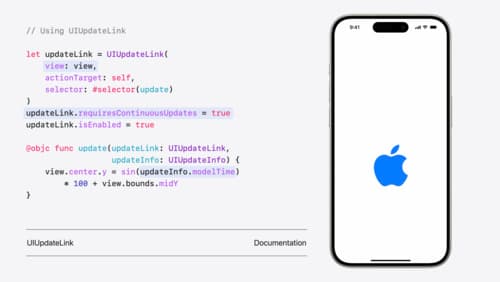What are the differences of ScrollView and UIScrollView?
Asked on 2024-08-06
1 search
The differences between ScrollView in SwiftUI and UIScrollView in UIKit are highlighted in several WWDC sessions. Here are some key points:
-
Declarative vs. Imperative:
- ScrollView (SwiftUI): SwiftUI uses a declarative syntax, meaning you describe what you want the UI to look like and let the framework handle the details.
- UIScrollView (UIKit): UIKit uses an imperative approach, where you explicitly manage the state and behavior of the UI components.
-
Modifiers and Customization:
- ScrollView (SwiftUI): SwiftUI provides various modifiers to customize the behavior and appearance of scroll views. For example, you can use the
scrollTransitionmodifier to create custom scroll effects, such as parallax or carousel effects (Create custom visual effects with SwiftUI). - UIScrollView (UIKit): Customization in
UIScrollViewoften requires more manual setup and handling, such as implementing delegate methods to respond to scrolling events.
- ScrollView (SwiftUI): SwiftUI provides various modifiers to customize the behavior and appearance of scroll views. For example, you can use the
-
Programmatic Control:
- ScrollView (SwiftUI): SwiftUI offers more programmatic control over scroll views, including new scroll positions and the ability to programmatically stop scrolling or control content alignment (What’s new in SwiftUI).
- UIScrollView (UIKit): While
UIScrollViewalso allows programmatic control, it typically involves more boilerplate code and manual state management.
-
Interoperability:
- ScrollView (SwiftUI): SwiftUI scroll views can be easily integrated with other SwiftUI components and benefit from SwiftUI's declarative nature.
- UIScrollView (UIKit): UIKit scroll views can be used within SwiftUI using
UIViewRepresentable, but this adds complexity and reduces the benefits of SwiftUI's declarative syntax.
-
New Features in SwiftUI:
- SwiftUI has introduced new scroll view modifiers specific to tvOS 18, such as
onScrollVisibilityChangeandscrollTargetBehavior, which enhance the customization and behavior of scroll views (Migrate your TVML app to SwiftUI).
- SwiftUI has introduced new scroll view modifiers specific to tvOS 18, such as
For a deeper dive into these differences, you can refer to the following sessions:

What’s new in UIKit
Explore everything new in UIKit, including tab and document launch experiences, transitions, and text and input changes. We’ll also discuss better-than-ever interoperability between UIKit and SwiftUI animations and gestures, as well as general improvements throughout UIKit.

What’s new in SwiftUI
Learn how you can use SwiftUI to build great apps for any Apple platform. Explore a fresh new look and feel for tabs and documents on iPadOS. Improve your window management with new windowing APIs, and gain more control over immersive spaces and volumes in your visionOS apps. We’ll also take you through other exciting refinements that help you make expressive charts, customize and layout text, and so much more.

SwiftUI essentials
Join us on a tour of SwiftUI, Apple’s declarative user interface framework. Learn essential concepts for building apps in SwiftUI, like views, state variables, and layout. Discover the breadth of APIs for building fully featured experiences and crafting unique custom components. Whether you’re brand new to SwiftUI or an experienced developer, you’ll learn how to take advantage of what SwiftUI has to offer when building great apps.
